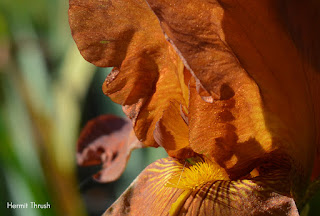by Jeff Bennett
When I began growing irises in about 1991, I ordered from Schreiner's, Cooley’s and Stockton Iris Gardens. Only from catalogs. There was no “online” back then. Imagine that! Back then, not many historic (more than 30 years old) irises were offered. 'Wabash' was often the go-to historic iris you could buy. I didn’t even know there were thousands of other ones with names. I liked 'Wabash' because it was so old! I also bought more recent varieties that were less expensive; paying around $3-4 each. Within a couple years, I purchased over 200 varieties. 'Jesse’s Song', a tall bearded iris hybridized by Bryce Williamson, had just won the Dykes Medal in 1991. It's now a Historic Iris.
 |
| Tall bearded iris 'Wabash' (Mary Williamson, 1936) |
 |
| Tall bearded iris 'Jesse's Song' (Bryce Williamson, 1983) |
 |
| Schreiner's Iris Garden Catalog, 1996 |
 |
| Stockton Iris Gardens' Catalog, 1997 |
As life continued, other important things like raising a family, running a business, and home improvement projects took priority. The irises existed out back but they were only paid attention during spring bloom. Then, in 2003, we moved to a bigger house with a smaller yard. I dug a few of each variety and left the rest for the new owner to enjoy. I wonder how many are left there? The rhizomes I brought with us eventually got planted at the new home, but most of the names had been lost. As time elapsed, fewer irises were thriving in the hard soil you get with a newly built home.
Fast forward 10 years to 2013. I started working at a public garden that had previously been private since its establishment in the 1930s. There were irises scattered about the main beds near the cottage. Of course, there were no names attached to them. I thought some of the varieties I used to grow would look great in this garden. I remembered that an iris society (the Mt. Diablo Iris Society) always had a booth at a local street fair and offered many varieties of bare-root rhizomes for sale. I found their booth and bought about thirty varieties for the garden. I recognized the names of some irises from my past, but most I did not. It had been 20 years.
Next, I started searching online for more varieties. Yes, the internet existed now, and search engines helped me locate those older varieties. The problem was, I still couldn’t find most of the varieties I had before. All of the sellers I was familiar with were selling the more recent popular introductions. I like the newer things but wanted what I knew I liked before. Irises hybridized during the 1970s and 1980s varieties were hard to find. Why? Everybody wants the newest introductions, and to get them, they have to make room and discard those old ones. The same goes for the sellers. Planting space is valuable, and what doesn’t sell goes to the "heap" to die alongside other unwanted plants.
I joined my local iris society--Mt. Diablo Iris Society in Walnut Creek, California--in 2014. Then I heard about The American Iris Society and their Iris Encyclopedia of all irises ever registered. I was astonished to find thousands and thousands of listed names in alphabetical order. And many of them didn’t even have photos. Even the descriptions were vague, but the names were pretty cool. I wondered what they looked like? I wrote a bunch of names down as my “LIST.” Now I know they must exist somewhere. Why would “THEY” let them disappear. The search was on.
I joined the American Iris Society in 2018 I believe, and then I discovered the Historic Iris Preservation Society (HIPS). Just by fate, I met two of its members (movers and shakers) at Dry Creek Garden, where I work. Dry Creek was one of the host gardens for the 2019 American Iris Society Convention in San Ramon, California. Nancy McDonald and Cathy Egerer both introduced themselves to me as HIPS members. They thanked me for having a separate Historic Iris Collection of about 200+ varieties that were blooming well for the Convention. I then also joined HIPS!
 |
| The HIPS publication Roots is sent to its members several times each year |
Now back to my 1980s irises. I realize that yesterday's irises were like old toys. When gardeners grow tired of them, they want new ones. Fluffy, Las Vegas showgirl-style irises. Some believe nobody wants old irises. I do! They are important. They document breakthroughs in form, color, and size. The first amoenas, first luminatas, first glaciatas, etc., are the parents of what we have today. You shouldn’t just throw your parents out.
Thousands have been lost to time. Do you have 'Brown Betty', 'Grace Mohr', 'Tobacco Road', 'Avalon', 'Easter Candle', 'Bronze Brocade', 'High Heels', 'Xanadu', 'Zulu Warrior', 'Pin Up Girl', or 'Head Hunter'? Most likely, you have never even heard of these. 'Tobacco Road' is believed extinct and 'Grace Mohr' may also have been lost. We don’t know the exact populations of historic varieties but we have an idea of some of them. There are ways you can help. Take an inventory of all your iris varieties. If they are from 1994 or earlier, they are now historic.
 |
| Tall bearded iris 'Cinnabar' (E. B. Williamson, 1928) |
 |
| Border bearded iris 'Gay Hussar' (E. B. Williamson, 1925) |
Once you have your list, join HIPS at www.historiciris.org. Register yourself and your collection in the member databank. It’s very easy to enter your varieties. Even if you think your iris is too common, enter it. It may be common only in your area due to being shared over the fence with friends, etc.
Let’s make old irises less rare!
 |
| Arilbred iris 'Oyez' (Clarance White, 1938) |


















































